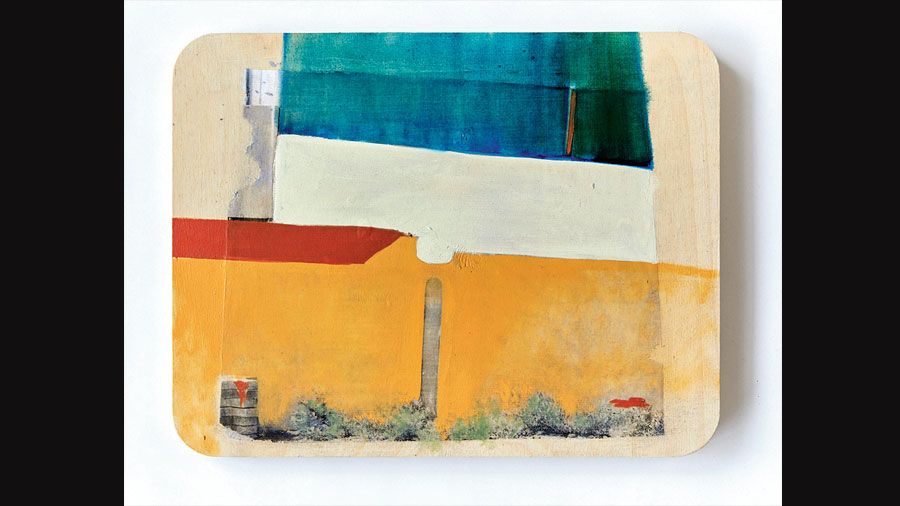How do you adorn a shadow? Drape the intangible with tactile matter? Trace substance as insentient or animate?
Well, Radhika Khimji’s art, on view at Experimenter (Ballygunge Place) till December 24, debates contraries through the enigma of the body, particularly the female body. It may seem modelled in its dimensions, but is strangely disembodied, flattened, faded, partly because of the technique of image transfer, perhaps; it’s present but also absent, evaporating into a void, leaving its peripheral frame behind sometimes, like the junk of life at death. Beguilingly adorned with dots of oil paint that conjure up gossamer veils, but also brutally exposed; torn apart, but somehow cobbled together, flesh kneaded into lumps or entangled in bizarre metamorphoses. As though it were a plaything for the pranks of spiteful gods lampooning human ideals of beauty, wholeness, and identity, overturning empirical presumptions about material reality.

The Dangler by Radhika Khimji. Experimenter
Adorning Shadows thus becomes an unsettling yet insouciant game of what is and what isn’t; what’s seen and what isn’t; what could be, or is about to become, aborted midway and hijacked into arbitrary formations, as one set of visual codes is pushed into unforeseen lexical antics. This skirmish of divergent identities, entities and thoughts, of matter and void, being and non-being, turns the body and its absence into multiple suggestions. In her non-figurative works, the artist sometimes takes a rather formalist approach. But most often, the shapes and tones, palpably unstable, wrestle with decay and disruptions that offer no reprieve from precariousness.
This precariousness runs through her work, as is apparent in See Through Stander, an ungainly 217 x 76 x 4 cm plexi figure, held firmly in place with an outline of plywood. It’s a startling metaphor for human vulnerability, especially the woman’s vulnerability, when her privacy is breached, with her sense of self under siege, violated by disrobing glares. But the image also resonates as an urban predicament beyond gender susceptibilities: the rootless anonymity of the individual lost in a crowd, his presence-in-the-flesh seemingly dissolved. Equally disconcerting because of the utter defenceless nakedness of its headless body is One-eyed Boobie. No less disturbing is Sitter, a cut-out of collapsing, cringing lumps that becomes part of an ambiguous little tableau.
Despite the modelled dimensions of the flesh — like in Sitter or Lick the Sky — form dodges labels, remains perversely indefinable: in the act of becoming, inchoate form merges with formless substance, keyed into a motion of mutation.That is, the animate and the inanimate emanate from each other, without any divinely ordained separation or vertical hierarchies. More intriguing with its reckless, surreal grafting of disparate hints is Curling Inward (picture, centre). The muscular dissonance of its somewhat Dalíesque aspect is like a visual allegory caught in a combative argument with its sub-plots.

Curling Inward by Radhika Khimji. Experimenter
The teasing dichotomy of The Dangler (picture, left) isn’t to be missed, either. This perforated aluminium sheet is as indecisive in its shape as in its dilemma: should it pose as solid and opaque, obstructing the invasive gaze? Or as a peek-a-boo screen, facilitating stealthy glimpses the way filigrees do? Is it worn-out and tattered like an old rag-picker’s moth-eaten wrap hung up to dry? Or must it advertise its sturdy resilience, sharp edges ready to retaliate against intruders?
A sensitive abstractionist, Khimji plays off contentious, corroded, heaving, evanescent layers of colour zones and forms, textures and marks against one another, a mix of references cited: architecture and semi-geometric naturescapes, bleak terrains and debris that may yet be dressed up in garlands of stitches and dots. This suite, in fact, demands a separate show and a longer critique than is possible here. The next time around, perhaps?










